UPDATE: ‘No changes to the lower East Rift Zone,’ HVO says
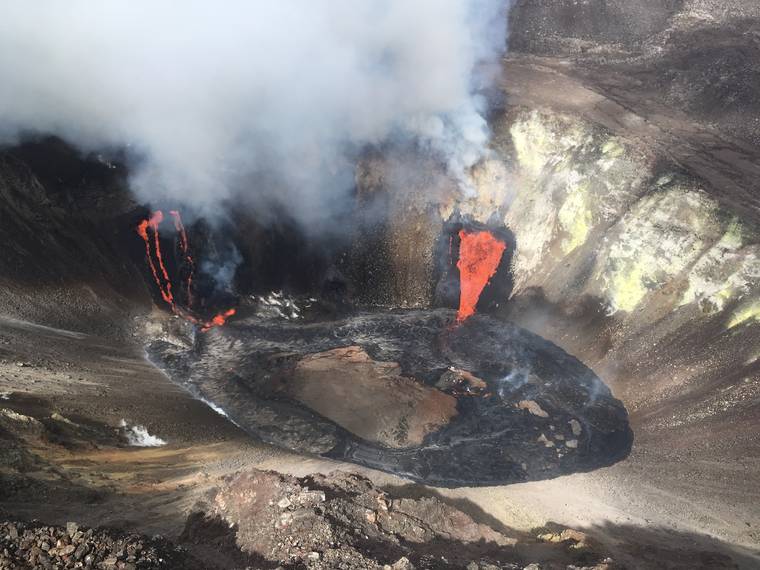
In this USGS photo taken during an overflight earlier today, two of the three fissures continue to add lava to the lava lake inside Halemaʻumaʻu crater.
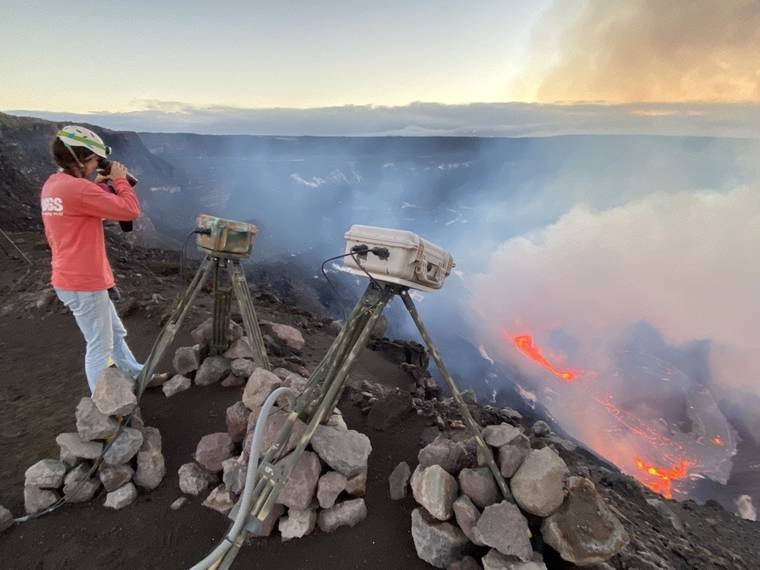
Dawn arrives at Kilauea's summit, where scientists are monitoring the new eruption within Kilauea caldera. Since Sunday night, three fissure vents on the wall Halemaʻumaʻu crater have fed lava into a growing lava lake. USGS photo.
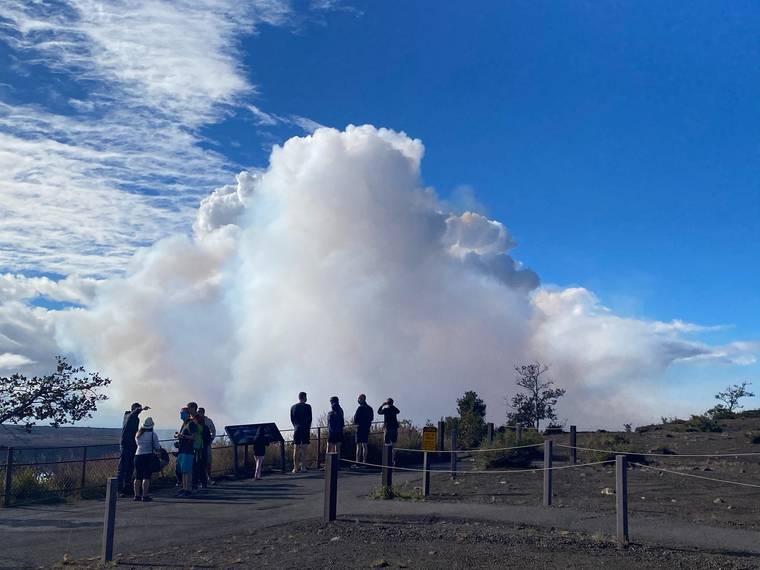
Visitors look on as a plume rises from Kilauea volcano's Halema‘uma‘u crater. Kilauea erupted Sunday night for the first time in more than two years.
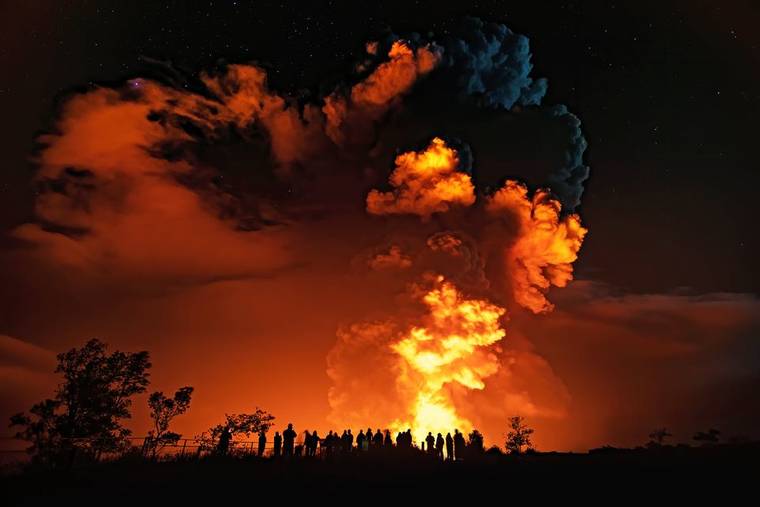
NPS Photo/J. Wei

Shortly after approximately 9:30 p.m. Sunday, an eruption commenced at the summit of Kilauea volcano. Red spots are the approximate locations of fissure vents feeding lava flowing into the bottom of Halema‘uma‘u crater. Lava fountains up to approximately 164 feet high were seen from the easternmost vent, with minor fountaining on the west side. USGS photo.
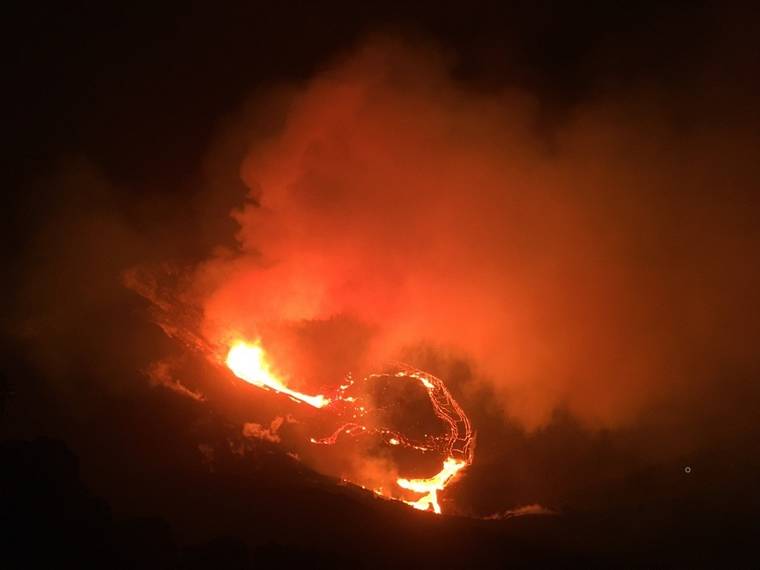
This is a USGS photo of Kilauea's summit eruption at 2:15 a.m. today. From the west rim of Kilauea caldera, a gas plume can be seen rising from Halemaʻumaʻu crater. This plume is drifting to the southwest with the trade winds. Increased sulfur dioxide (SO2) emission rates associated with new eruption may lead to voggy conditions downwind.
UPDATED 2:40 p.m.
UPDATED 2:40 p.m.
In a tweet this afternoon, HVO stressed “that the current activity at Kilauea’s summit is confined to Halemaʻumaʻu crater within Hawaii Volcanoes National Park. Monitoring data show no changes to the lower East Rift Zone or other parts of the volcano.”
ADVERTISING
UPDATED 1:30 p.m.
Hawaiian Volcano Observatory scientists conducted a helicopter overflight of Kilauea’s summit this morning. The overflight revealed that two of the three fissures are still active and feeding lava into the new lava lake inside Halemaʻumaʻu crater.
UPDATED 11:05 a.m.
Activity over the past 10 hours at Kilauea volcano has been characterized by three fissure vents on the north and northwest walls of Halemaʻumaʻu crater, according to the USGS.
Fountaining lava at these vents is estimated to be up to 82 feet high. The vents are feeding lava flows into the base of Halemaʻumaʻu crater, which is being filled with a growing lava lake.
The lava lake has been rising approximately several yards an hour since the eruption began. The current lava lake exhibits a circulating perimeter, but stagnant center.
The event has been accompanied by only moderate amounts of deformation, indicating deflation of a magma reservoir under Halemaʻumaʻu. Rates of tilting have decreased slightly since the beginning of the eruption.
Increased rates of seismicity in the summit region continue. Some of these earthquakes may be felt.
UPDATED 6:13 a.m.
Civil Defense reported at 6:09 a.m. that “the situation at the Halema‘uma‘u crater of the Kilauea volcano has stabilized.”
“The crater lake has evaporated and is slowly being replaced with a lava lake,” according to Civil Defense. “The threat of ash fallout is very low but is possible in the Ka‘u and South Kona districts.”
PREVIOUSLY
Kilauea volcano began erupting again Sunday night for the first time since 2018.
As of 5 a.m. today, the eruption was contained to Kilauea’s summit caldera in Hawaii Volcanoes National Park.
The eruption started Sunday at approximately 9:30 p.m., with multiple fissures opening on the walls of Halema‘uma‘u crater.
The lava cascaded into the summit water lake, boiling off the water and forming a new lava lake at the base of the crater, according to the U.S. Geological Survey.
The northern fissure produced a lava fountain 165 feet high. All lava was contained within Halemaʻumaʻu crater.
The USGS’s Hawaiian Volcano Observatory recorded a magnitude-4.4 earthquake located beneath Kilauea’s south flank at 10:36 p.m. Sunday.
The earthquake was centered about 8.7 miles south of Fern Forest, near the Holei Pali area of Hawaii Volcanoes National Park at a depth of 4 miles.
Weak to light shaking was reported across the the Big Island. Significant damage to buildings or structures was not expected.
According to HVO acting Scientist-in-Charge David Phillips, “HVO continues to monitor Kilauea as the situation is rapidly evolving with this evening’s eruption at the summit of Kilauea. We will send out further notifications on Kilauea and other Hawaiian volcanoes as we observe changes.”
Hawaii County Civil Defense said in an alert at 11:20 p.m. Sunday that “trade winds will push any embedded ash toward the southwest. Fallout is likely in the Ka‘u District in Wood Valley, Pahala, Naalehu and Ocean View. Stay indoors to avoid exposure to ash.”
Civil Defense also said the earthquake did not generate a tsunami threat.


